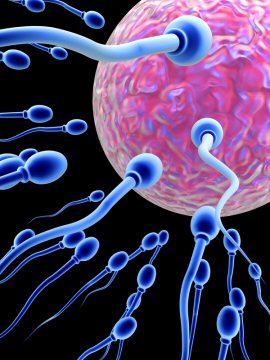 A rare form of testicular tumor has serendipitously provided scientists with new insights into why certain diseases are more common in the children of older fathers.
A rare form of testicular tumor has serendipitously provided scientists with new insights into why certain diseases are more common in the children of older fathers. Writing in Nature Genetics, scientists from the University of Oxford and Copenhagen University explain how mutations can occur in different cells of the body and at different times during life. Some, such as those which occur in germ cells (those which create sperm or eggs), cause changes which affect the offspring; those which occur in other cells can lead to tumors, but are not inherited.
The researchers then describe a surprising link between certain severe childhood genetic disorders and rare testicular tumors occurring in older men: the germ cells that make the mutant gene-carrying sperm seem to be the same cells that produce the tumor.
Although the original mutations occur only rarely in the sperm-producing cells, they encourage the mutant cells to divide and multiply. When the cell divides, it copies the mutation to each daughter cell, and the clump of mutant sperm-producing cells expands over time. Hence, the number of sperm carrying this mutation also increases as men get older, raising the risk to older fathers of having affected children.
"We think most men develop these tiny clumps of mutant cells in their testicles as they age. They are rather like moles in the skin, usually harmless in themselves. But by being located in the testicle, they also make sperm - causing children to be born with a variety of serious conditions. We call them 'selfish' because the mutations benefit the germ cell but are harmful to offspring," explained study leader Professor Andrew Wilkie, from the University of Oxford.
The new work helps explain the origins of several serious conditions that affect childhood growth and development. These include achondroplasia and Apert, Noonan and Costello syndromes, as well as some conditions causing stillbirth. The research links these conditions to a single pathway controlling cell multiplication. The findings may also help explain one of the mysteries of genetics: why scientists have yet to account for much of the genetic component of common diseases. Common diseases tend to be caused by the interaction of many genes, but despite powerful genome-wide association scans to search for these genes, relatively few have been uncovered. Several of these diseases, including breast cancer, autism and schizophrenia, seem to be more frequent in the offspring of older fathers, but the reasons are unknown. Professor Wilkie suggests that similar - but milder - mutations might contribute to these diseases.
"What we have seen so far may just be the tip of a large iceberg of mildly harmful mutations being introduced into our genome," Wilkie noted. "These mutations would be too weak and too rare to be picked up by our current technology, but their sheer number would have a cumulative effect, leading to disease."
Related:
Older dads: time is NOT on your side
Older Sperm More Likely To Produce Bipolar Kids
Older Sperm Behind Genetic Mutations
Source: Nature Genetics





